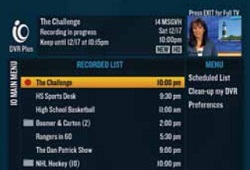Cablevision's Network DVR Can Record 10 Shows at Once: Updated

Cablevision Systems has quietly rebranded and upgraded its network-based DVR service, gracing it with several feature enhancements, including one that allows video subscribers to record up to 10 programs while they watch any live or pre-recorded show.
The MSO has not yet made any formal, splashy announcements about these changes, but recently altered Web pages on the Cablevision customer-facing Web site reveal that the operator has changed the product name from “DVR Plus” to “Multi-Room DVR” in tandem with the enhancements and a new, higher price of $12.95 per month. (See updated information below.)
In addition to the beefed up simultaneous recording capabilities, Cablevision’s new Multi-Room DVR offering also expands storage to 75 hours of high-definition programming or over 300 hours of standard definition programming.
Cablevision’s original DVR Plus service, launched in January 2011 in the Bronx, offers 100 hours of SD storage or 25 hours of HD storage for $10.95 per month, and the ability to record up to four shows at the same time, while watching a fifth already-recorded program.
According to the Multi-Room DVR user guide (PDF), Cablevision is giving existing DVR Plus customers the option to upgrade to the higher level tier for the extra $2 per month, directing them to tune to channel 905 for more details.
Cablevision’s network-based service offers many features that are found in more traditional multi-room DVR set-ups that rely on local storage and coax-based high-speed networking systems. For example, Cablevision’s product supports a 15 minute live TV buffer, the ability to set up season recordings, and gives customers the ability to manage and schedule recordings remotely via the Optimum App for iOS- and Android-powered tablets and smartphones. On Tuesday, Cablevision declined to comment about the new upgraded Multi-Room DVR beyond the details that are currently posted on its customer site.
Update: Cablevision announced the enhancedments to its cloud DVR service on Wednesday. “Multi-Room DVR gives customers control over when and where they watch TV in the home. Customers can record 10 shows at once, more than FiOS and DirecTV combined, with hundreds of hours of storage for their favorite shows,” said Bradley Feldman, vice president of video product management for Cablevision, in a statement. “Our cloud-based DVR is the industry’s most advanced DVR service and provides customers with the flexibility they need to enjoy the programming they love without being forced to choose between shows.”
Multichannel Newsletter
The smarter way to stay on top of the multichannel video marketplace. Sign up below.
DirecTV’s new Genie DVR is capable of recording five shows at the same time, a feature that the satellite TV giant has been using to disparage the recording capabilities of most currently deployed MSO-supplied DVRs.
The upgrade comes as Cablevision gets its network DVR product rolled out across the majority of its footprint in New York, Connecticut and New Jersey. The only Cablevision market that's currently without access is Hamilton, N.J.
In May during the MSO’s first quarter earnings call, Kristin Dolan, president of Optimum Services, said Cablevision had more than 300,000 customers are taking the company’s DVR Plus package.
CableCARD-based devices and eSATA drives are not compatible with Cablevision’s Multi-Room DVR product. The MSO, which has deployed a downloadable conditional access system, has selected Humax and Samsung to develop a next-gen “Future Services Portal” set-top that will focus on cloud-based services and apps, including the MSO’s network-based DVR and an advanced user interface.
For now, recordings made to Cablevision’s network-based DVR are accessible only on set-tops.
Comcast is testing a Cloud DVR service in Philadelphia and Boston that will playback recordings in the home on set-tops, tablets, smartphones and other devices outfitted with “X2,” an updated version of the MSO’s video interface/operating system that Comcast is expected to begin deploying this fall.
